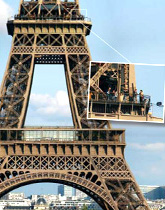The young boy, growing up in a small town in Texas, spends time at the local library paging through issues of National Geographic—a magazine known for pictorials on everything from African villages to outdoor markets in Morocco. The pictures are intriguing, but they're also limited. Is that a lion lurking behind the dancing African tribesmen? How much money is the Moroccan woman handing the rug dealer? What is the camera missing? The young boy, Randy Sargent, wants to see more than what the photos capture.

Years later, he is working at NASA's Ames Research Center as part of the Intelligent Robotics Group, a division tasked with, among other things, projects relating to the Mars Rovers. Sargent has a hand in developing technologies that allow the rovers to send back pictures of the Martian landscape. As the pictures come in, software stitches them together; they're printed and hung on the wall. When Sargent stands in front of the incredibly vivid panorama, the contours of every rock are in focus. Awestruck at what the technology has produced, he feels like he's standing on Mars.
That year, a Carnegie Mellon professor on sabbatical, Illah Nourbakhsh, was hired by NASA to lead Sargent's research group. On his first day, the new boss gathers the researchers together and asks them a simple question; "If you could do anything you wanted [with your research], what would you do?" Sargent doesn't have to ponder his answer: Why not take the panoramic technology used on Mars and train it on our own planet?
Nourbakhsh is intrigued. The duo, working with teams at Carnegie Mellon and NASA, tinker with spare parts that Sargent says can be found in any roboticist's garage. The result is GigaPan, which is compatible with most digital cameras. Users simply attach a camera onto a small robotic mount that automates the picture-taking process. Next, hundreds or thousands of resulting images are downloaded to a computer, and the GigaPan software combines them into one zoom-in, zoom-out photo. Just one example, which prompted nearly 10 million views on the Internet, is a panorama of the inauguration of Barack Obama, rendered in such staggering detail that viewers get a shot of the multitude of people assembled and in the same photo can zoom in close enough to see Joe Biden's cufflinks.
GigaPan, which retails for less than $400, has garnered its share of headlines—London's Times Online reports that GigaPan was its most widely read technology story for 2008--but Sargent and Nourbakhsh envision their creation as more of a populist technology. "We felt that letting people explore the world and zoom in to see different places would help people develop empathy and understanding for each other," says Sargent, now a scientist at Carnegie Mellon's Silicon Valley campus. For anyone browsing GigaPan's Web site, www.gigapan.org, there are thousands of examples of that beginning to happen as part of the Global Connection Project—people visually documenting their vacations, their neighborhoods, their lives.
To see if you recognize anyone standing on the Eiffel Tower's observation deck, simply zoom in on the photo at: www.gigapan.org



